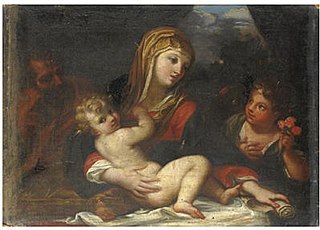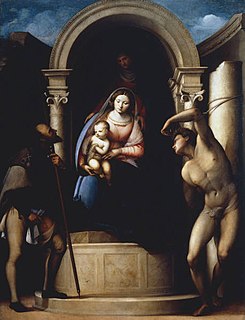
BartolomeoMontagna was an Italian Renaissance painter who mainly worked in Vicenza. He also produced works in Venice, Verona, and Padua. He is most famous for his many Madonnas and his works are known for their soft figures and depiction of eccentric marble architecture. He is considered to be heavily influenced by Giovanni Bellini, in whose workshop he might have worked around 1470. Benedetto Montagna, a productive engraver, was his son and pupil and active until about 1540. He was mentioned in Vasari's Lives as a student of Andrea Mantegna but this is widely contested by art historians.

Alessandro Bonvicino, more commonly known as Moretto, or in Italian Il Moretto da Brescia, was an Italian Renaissance painter from Brescia, where he also mostly worked. His dated works span the period from 1524 to 1554, but he was already described as a master in 1516. He was mainly a painter of altarpieces that tend towards sedateness, mostly for churches in and around Brescia, but also in Bergamo, Milan, Verona and Asola; many remain in the churches they were painted for. Most are on canvas, but a number even of large ones are on wood panel. Only a handful of drawings survive.

Claudio Coello was a Spanish Baroque painter. Coello is considered the last great Spanish painter of the 17th century.

Giovanni Battista Cima, also called Cima da Conegliano, was an Italian Renaissance painter, who mostly worked in Venice. He can be considered part of the Venetian school, though he was also influenced by Antonello da Messina, in the emphasis he gives to landscape backgrounds and the tranquil atmosphere of his works. Once formed his style did not change greatly. He mostly painted religious subjects, often on a small scale for homes rather than churches, but also a few, mostly small, mythological ones.

Taddeo di Bartolo, also known as Taddeo Bartoli, was an Italian painter of the Sienese School during the early Renaissance. He is among the artists profiled in Vasari's biographies of artists or Vite. Vasari claims he is the uncle of Domenico di Bartolo.

Girolamo Romani (Romanino) was an Italian High Renaissance painter active in the Veneto and Lombardy, near Brescia. His long career brought forth several different styles.

Antonio Vassilacchi, also called L'Aliense, was a Greek painter, who was active mostly in Venice and the Veneto.

Giacinto Calandrucci was an Italian painter of the Baroque period.
Giuseppe Badaracco (1588–1657), also called “Il Sordo”, was an Italian painter of the Baroque period, active mainly in Genoa, in Liguria and in the island of Corsica.

Giovanni Buonconsiglio was an Italian painter of the Renaissance period, active mainly in Venice and his native Vicenza. Alternate names: Bonconsigli, Giovanni; Il Marescalco; Marescalco Buonconsiglio; Il Marescalco.
Onofrio Gabrieli or Gabriello was an Italian painter of the Baroque period.

Gregorio Pagani was an Italian painter of the late 16th century, active mainly in Florence. He was the son of the painter Francesco Pagani, then became a pupil of Santi di Tito, then entered the studio of Ludovico Cigoli. He painted the St. Helena finding the Cross for Santa Maria del Carmine, which was lost in the fire at the church in 1771. He painted a Nativity for the cathedral of Santa Maria del Fiore. Among his pupils were Cristofano Allori and Matteo Rosselli.

Aurelio Lomi was an Italian painter of the late-Renaissance and early-Baroque periods, active mainly in his native town of Pisa, Tuscany.
Antonio Capulongo was an Italian painter of the late-Renaissance period.

Biagio d’Antonio Tucci was an Italian Renaissance painter active in Florence, Faenza and Rome.

Lorenzo Canozzi or Canozio (1425–1477), also called Lorenzo da Lendinara, was an Italian painter of the Renaissance.
Francesco Nasini was an Italian painter of the Baroque period, active mainly in towns outside of Siena, Italy.

Sebastiano Florigerio was an Italian painter of the Renaissance period.

Giuseppe Oriolo or Orioli was an Italian painter of the late-Baroque.

Agostino Ugolini was an Italian painter, active in a late-Baroque and early-neoclassic style.
















